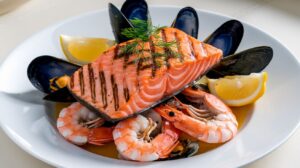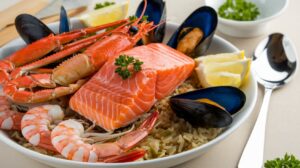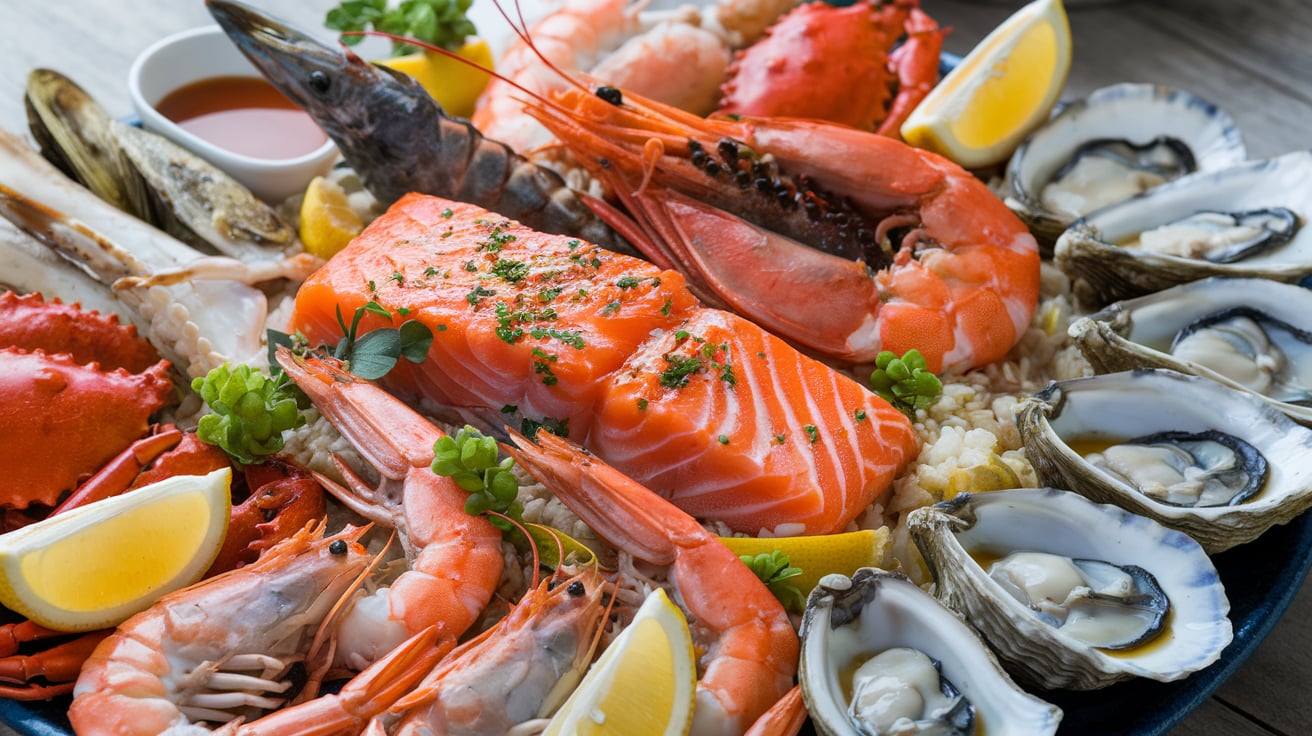Puerto Rican Pernil: A Flavorful and Timeless Tradition
Introduction
Puerto Rican pernil is a beloved and iconic dish from the Caribbean, especially during festive seasons like Christmas and family celebrations. This slow-roasted pork dish is marinated with a blend of spices and seasonings such as sofrito, adobo, and sazón, resulting in a rich, tender, and flavorful roast. The perfect combination of crispy skin and juicy meat makes it a family favorite that has stood the test of time.
If you’re looking for an authentic recipe or a deeper understanding of this iconic dish, check out this detailed guide to Puerto Rican pernil from The Noshery and Chili Pepper Madness’ Guide to Pernil.
What Is Puerto Rican Pernil?
Pernil is essentially a Puerto Rican roast pork, typically made from a pork shoulder or pork leg. The meat is marinated with a combination of seasonings and slow-roasted to create a dish with rich flavors and a crispy skin. While the term pernil is used broadly across Latin American countries, the Puerto Rican version is unique due to its use of specific seasonings like sofrito and adobo.
In Puerto Rico, pernil is a symbol of celebration, often gracing the tables during holiday feasts, especially Nochebuena (Christmas Eve). It is traditionally served with sides like arroz con gandules (rice with pigeon peas) and tostones (fried plantains), making it a centerpiece of the Puerto Rican dining experience.
The Historical Background of Puerto Rican Pernil
Roots of Pernil in Puerto Rican Culture
Pernil has a long history in Puerto Rican cuisine, influenced by a mix of indigenous Taino, African, and Spanish culinary traditions. The Taino people, who were the island’s original inhabitants, introduced the concept of slow-roasting meats, which the Spanish colonizers later refined with their own cooking methods. Over time, African influences also shaped the seasoning and marination techniques that make pernil so distinct today.
Puerto Rican pernil is a dish that transcends generations, evolving while maintaining the essence of Puerto Rican culture. The concept of marinating meat with garlic, onions, and herbs can be traced back to these early influences, creating a robust flavor profile that is enjoyed to this day.
For more on the history of pernil and its cultural significance, check out The History of Pernil by The Noshery.
Ingredients and Seasonings for Puerto Rican Pernil

To make an authentic Puerto Rican pernil, you’ll need the right ingredients and seasonings. Here’s what you’ll need:
- Pork Shoulder or Pork Leg: The best cuts for pernil are the pork shoulder or pork leg. These cuts are perfect because they are marbled with fat, which ensures the meat remains juicy and tender after roasting.
- Sofrito: This Puerto Rican cooking base is made with onions, garlic, peppers, cilantro, and spices. It’s essential to the flavor profile of the dish.
- Adobo Seasoning: This seasoning is typically made with garlic, oregano, salt, pepper, and other spices. It is a must-have when cooking pernil, as it enhances the savory flavors.
- Sazón: A seasoning mix that includes annatto, cumin, garlic powder, and sometimes, coriander. It adds depth and color to the dish.
- Garlic and Cumin: These two spices are key in pernil recipes. Garlic provides robust flavor, while cumin adds a subtle earthy undertone.
- Oregano: Oregano is essential in Puerto Rican cuisine. It adds a fresh, herbal flavor that enhances the dish’s complexity.
- Vinegar or Orange Juice: These ingredients help tenderize the meat and provide a tangy contrast to the rich flavors of the pork.
These ingredients, when combined, create a perfect balance of savory, tangy, and aromatic flavors that are the hallmark of Puerto Rican pernil.
How to Marinate Pernil for Maximum Flavor
Marinating your pernil is one of the most important steps to ensure that the flavors really infuse into the meat. Here’s how to marinate it properly:
1. Prepare the Marinade
To start, you’ll need a combination of your favorite spices, including sofrito, adobo, sazón, and garlic. You can make your own sofrito by blending together onions, peppers, garlic, cilantro, and oil. This creates the aromatic base for your marinade.
- 1/4 cup sofrito
- 1 tablespoon adobo
- 2 teaspoons sazón
- 6 cloves garlic, minced
- 2 teaspoons cumin
- 1 teaspoon oregano
- 1/4 cup vinegar or orange juice
- Salt and pepper to taste
Mix all the ingredients together in a bowl, forming a thick paste. This mixture will marinate the pork, allowing the flavors to penetrate deeply.
2. Season the Meat
Rub the marinade all over the pork shoulder or pork leg. Be sure to get the marinade into every nook and cranny of the meat. For extra flavor, make small incisions in the meat and stuff the marinade inside. This will allow the flavors to infuse from the inside out.
3. Let the Pork Rest
Cover the pernil with plastic wrap and let it marinate for at least 4-6 hours, but ideally overnight. The longer you let it marinate, the deeper the flavor will be.
Cooking Puerto Rican Pernil: The Traditional Method
There are several methods to cook pernil, but the most popular and traditional way is roasting it in the oven. Here’s how to do it:
1. Preheat the Oven
Preheat your oven to 350°F (175°C). Make sure it is fully heated before placing the pork inside.
2. Prepare the Roasting Pan
Place the marinated pernil in a roasting pan. You can use a rack to lift the meat off the bottom of the pan to allow air circulation, ensuring even cooking. If you don’t have a rack, simply place the pork directly in the pan, skin-side up.
3. Roast the Pernil
Roast the pernil for about 3-4 hours, depending on the size of the cut. Every 30-45 minutes, baste the meat with its own juices to keep it moist. For a crispy skin, increase the temperature during the last 30 minutes of cooking, or broil the meat for a few minutes at the end.
Check the internal temperature with a meat thermometer. The pork is done when it reaches an internal temperature of 190°F (88°C), ensuring the meat is tender and easily pulled apart.
Serving and Pairing Puerto Rican Pernil
Once your pernil is cooked to perfection, it’s time to serve it! Traditionally, Puerto Rican pernil is served with a variety of side dishes:
- Arroz con Gandules: A traditional rice dish made with pigeon peas and seasoned with sofrito, it is a classic pairing with pernil.
- Tostones: Fried plantains, crispy on the outside and soft inside, are the perfect complement to the savory pork.
- Mango Salsa: For a tropical twist, serve pernil with a fresh mango salsa, balancing the savory flavors with a touch of sweetness.
For more about traditional Puerto Rican sides and serving suggestions, visit this Puerto Rican Sides Guide.
Modern Variations of Puerto Rican Pernil
While traditional pernil is beloved, modern twists on this classic dish are becoming increasingly popular. Here are some exciting variations to try:
- Pernil Tacos: Use pernil as a filling for tacos, topped with salsa, guacamole, and fresh cilantro.
- Pernil Sliders: Mini sandwiches made with slow-cooked pernil on soft rolls, perfect for parties and gatherings.
Storing and Reheating Pernil

Storing Leftovers
You can store leftover pernil in an airtight container for up to 3 days in the refrigerator. For longer storage, freeze the pork for up to 2 months. When reheating, ensure that the meat is fully heated through, and for crispy skin, finish it off in the oven under the broiler.
Reheating Tips
Reheat your pernil at a low temperature (around 300°F or 150°C) to avoid drying it out. To preserve the crispy skin, broil for a few minutes at the end.
FAQs About Puerto Rican Pernil
- What cut of pork is best for pernil?
- The ideal cuts are pork shoulder or pork leg, which are rich in fat and will result in a tender, juicy roast.
- Can pernil be cooked in a slow cooker?
- Yes, but the skin will not become as crispy. You can still achieve a tender, flavorful roast using a slow cooker.
- How do I get crispy skin on pernil?
- Ensure the pernil is roasted skin-side up and finish it under the broiler for a few minutes to crisp the skin.
- Can I make pernil ahead of time?
- Yes, you can marinate the meat a day ahead, and the roast can be stored in the refrigerator until ready to cook.
- How long does pernil need to marinate?
- Marinate the pork for at least 4-6 hours, but overnight is ideal for maximum flavor.
Conclusion
Puerto Rican pernil is more than just a meal; it’s a cultural treasure that brings family and friends together around the table. With its rich history, mouthwatering flavors, and versatility, pernil is a dish worth celebrating and sharing with loved ones.
For more Puerto Rican recipes and tips on cooking, visit The Noshery.
Print
Salmon Seafood Symphony Delight
Description
Discover how to make authentic Puerto Rican Pernil, a tender, juicy roast pork with crispy skin, perfect for family gatherings and festive meals.
Ingredients
- Pork Shoulder or Pork Leg: The best cuts for pernil are the pork shoulder or pork leg. These cuts are perfect because they are marbled with fat, which ensures the meat remains juicy and tender after roasting.
- Sofrito: This Puerto Rican cooking base is made with onions, garlic, peppers, cilantro, and spices. It’s essential to the flavor profile of the dish.
- Adobo Seasoning: This seasoning is typically made with garlic, oregano, salt, pepper, and other spices. It is a must-have when cooking pernil, as it enhances the savory flavors.
- Sazón: A seasoning mix that includes annatto, cumin, garlic powder, and sometimes, coriander. It adds depth and color to the dish.
- Garlic and Cumin: These two spices are key in pernil recipes. Garlic provides robust flavor, while cumin adds a subtle earthy undertone.
- Oregano: Oregano is essential in Puerto Rican cuisine. It adds a fresh, herbal flavor that enhances the dish’s complexity.
- Vinegar or Orange Juice: These ingredients help tenderize the meat and provide a tangy contrast to the rich flavors of the pork.
Instructions
- 1/4 cup sofrito
- 1 tablespoon adobo
- 2 teaspoons sazón
- 6 cloves garlic, minced
- 2 teaspoons cumin
- 1 teaspoon oregano
- 1/4 cup vinegar or orange juice
- Salt and pepper to taste

